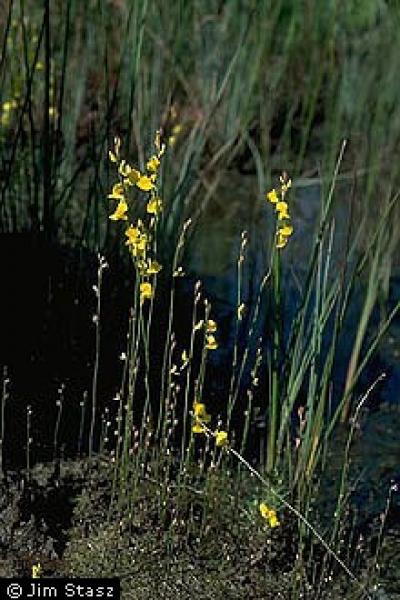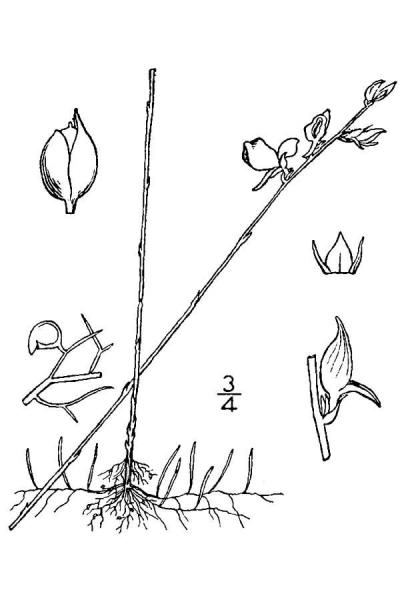Rush Bladderwort
Utricularia juncea Vahl
- Class
- Dicotyledoneae (Dicots)
- Family
- Lentibulariaceae (Bladderwort Family)
- State Protection
- Endangered
Listed as Endangered by New York State: in imminent danger of extirpation in New York. For animals, taking, importation, transportation, or possession is prohibited, except under license or permit. For plants, removal or damage without the consent of the landowner is prohibited.
- Federal Protection
- Not Listed
- State Conservation Status Rank
- S1
Critically Imperiled in New York - Especially vulnerable to disappearing from New York due to extreme rarity or other factors; typically 5 or fewer populations or locations in New York, very few individuals, very restricted range, very few remaining acres (or miles of stream), and/or very steep declines.
- Global Conservation Status Rank
- G5
Secure globally - Common in the world; widespread and abundant (but may be rare in some parts of its range).
Summary
Did you know?
Genus name is Latin for having a little bladder or bottle. It refers to the insect-catching underwater bladders of these plants (Fernald 1950). Some earlier treatments of the genus thought that this species was not separate from Utricularia cornuta. They both have linear leaves like those in the rush genus Juncus, thus the species name (Schnell 2002).
State Ranking Justification
There are four existing populations and three of them consist of multiple, hydrologically connected ponds. Populations at each site are only in the hundreds. There are two populations from the early 1900s which have not been resurveyed.
Short-term Trends
There have not been sufficient surveys to understand the short-term trends of this species, especially with a species that fluctuates according to water levels.
Long-term Trends
The long-term trend appears to be stable. This plant has always been rare in New York and the number of populations has remained about the same over last 100 years.
Conservation and Management
Threats
Some ponds have seen too much development along the shoreline which threaten populations with direct disturbance by trampling and ATV use. The invasion of Phragmites is also a threat to a few populations.
Conservation Strategies and Management Practices
The pondshores need to be protected from direct disturbance from ATVs and excessive trampling. Exotic invasive species must be prevented from colonizing the shores and any existing populations must be eliminated. A natural buffer of at least 200 feet should be established around the ponds to prevent excessive runoff and pollution events.
Research Needs
Research is needed into the habitat preferences, seed banking characteristics, and successful techniques for augmenting existing populations.
Habitat
Habitat
This species occurs almost exclusively on coastal plain pondshores. However, one population does occur in a boggy sedge meadow with white cedar at the edge (New York Natural Heritage Program 2012). Wet shores (Gleason and Cronquist 1991). Wet sandy places that are frequently flooded by a few centimeters of water in particularly wet times (Schnell 2002).
Associated Ecological Communities
- Coastal plain pond shore
(guide)
The gently sloping shore of a coastal plain pond with seasonally and annually fluctuating water levels. Plants growing on the pond shore vary with water levels. In dry years when water levels are low there is often a dense growth of annual sedges, grasses, and herbs. Submerged and floating-leaved aquatic plants, such as fragrant waterlily and pondweeds, may become "stranded" on the exposed shore. In wet years when the water level is high only a few emergents and floating-leaved aquatics may be noticeable. T
Associated Species
- Chamaecyparis thyoides (Atlantic white cedar)
- Cyperus
- Drosera intermedia (spatulate-leaved sundew)
- Eleocharis
- Eleocharis robbinsii (Robbins's spike-rush)
- Gratiola aurea (golden hedge-hyssop)
- Hypericum canadense (lesser Canadian St. John's-wort)
- Juncus militaris (bayonet rush)
- Sarracenia purpurea (purple pitcherplant)
- Scleria reticularis (netted nut sedge)
- Utricularia striata (striped bladderwort)
- Xyris smalliana (Small's yellow-eyed-grass, large yellow-eyed-grass)
Range
New York State Distribution
This small carnivorous plant is currently known from Suffolk County, Long Island with historical records to the west in Nassau County. There is also an unconfirmed report from Ulster County which is probably in error.
Global Distribution
This carnivorous plant occurs from Long Island south along the Atlantic Coastal Plain to northern Florida and west along the Gulf Coast from the panhandle of Florida to East Texas.
Identification Comments
General Description
Rush bladderwort is a terrestrial bladderwort with leaves that are mostly subterranean and seldom seen. The flowering peduncles are 40 cm tall and always purple towards the bottom. There are 4-32 nodes along the peduncle and the little bractlets are slender and pointed. There are open and closed flowers on the same stem or within the colony. The flowers are bright yellow and have upper lips that are shorter than the lower lips whose lateral edges fold down into a prominent, apronlike appearance. The spur is vertical and stands out away from the lower lip. The open flowers are 1 cm long and not fragrant (Schnell 2002).
Identifying Characteristics
JUNCUS LIKE ROUNDED STIFF STEMS, NO LEAVES. SPUR HORIZONTAL PROMINENT
Best Life Stage for Proper Identification
This bladderwort can only be identified in flower.
Similar Species
The common horned bladderwort, Utricularia cornuta, looks very similar but it is generally larger and the more clustered flowers are only open flowers, never a combination of open and closed flowers. It flowers in the spring and the peduncles are not purple at the bottom. The flowers are 2 cm long and fragrant (Schnell 2002). It grows upstate as well as along the Long Island coast.
Best Time to See
The best time to identify the species is July through September.
- Flowering
The time of year you would expect to find Rush Bladderwort flowering in New York.
Rush Bladderwort Images
Taxonomy
Rush Bladderwort
Utricularia juncea Vahl
- Kingdom Plantae
- Phylum Anthophyta
- Class Dicotyledoneae
(Dicots)
- Order Scrophulariales
- Family Lentibulariaceae (Bladderwort Family)
- Order Scrophulariales
- Class Dicotyledoneae
(Dicots)
- Phylum Anthophyta
Synonyms
- Utricularia virgatula Barnh.
Additional Resources
Best Identification Reference
Crow, Garrett E. and C. Barre Hellquist. 2000. Aquatic and Wetland Plants of Northeastern North America: A revised and enlarged edition of Norman C. Fassett's a Manual of Aquatic Plants. Volume One: Pteridophytes, Gymnosperms, and Angiosperms: Dicotyledons. The University of Wisconsin Press. Madison, Wisconsin. 536 Pages.
Other References
Fernald, M.L. 1950. Gray's manual of botany. 8th edition. D. Van Nostrand, New York. 1632 pp.
Gleason, Henry A. and A. Cronquist. 1991. Manual of Vascular Plants of Northeastern United States and Adjacent Canada. The New York Botanical Garden, Bronx, New York. 910 pp.
Holmgren, Noel. 1998. The Illustrated Companion to Gleason and Cronquist's Manual. Illustrations of the Vascular Plants of Northeastern United States and Adjacent Canada. The New York Botanical Garden, Bronx, New York.
House, Homer D. 1924. Annotated list of the ferns and flowering plants of New York State. New York State Museum Bulletin 254:1-758.
Mitchell, Richard S. and Gordon C. Tucker. 1997. Revised Checklist of New York State Plants. Contributions to a Flora of New York State. Checklist IV. Bulletin No. 490. New York State Museum. Albany, NY. 400 pp.
New York Natural Heritage Program. 2010. Biotics database. New York Natural Heritage Program. New York State Department of Environmental Conservation. Albany, NY.
New York Natural Heritage Program. 2024. New York Natural Heritage Program Databases. Albany, NY.
Schnell, Donald E. 2002. Carnivorous Plants of the United States and Canada. Second edition. Timber Press, Portland, Oregon.
Taylor, Norman. 1915. Flora of the vicinity of New York. Memoirs of the New York Botanical Garden vol. V. New York, NY.
Weldy, T. and D. Werier. 2010. New York flora atlas. [S.M. Landry, K.N. Campbell, and L.D. Mabe (original application development), Florida Center for Community Design and Research http://www.fccdr.usf.edu/. University of South Florida http://www.usf.edu/]. New York Flora Association http://newyork.plantatlas.usf.edu/, Albany, New York
Links
About This Guide
This guide was authored by: Stephen M. Young
Information for this guide was last updated on: September 20, 2012
Please cite this page as:
New York Natural Heritage Program. 2024.
Online Conservation Guide for
Utricularia juncea.
Available from: https://guides.nynhp.org/rush-bladderwort/.
Accessed July 27, 2024.

